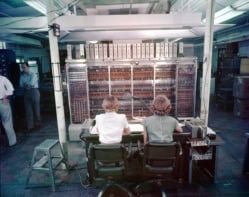Matin Durrani reviews The Newton Papers: the Strange and True Odyssey of Isaac Newton’s Manuscripts by Sarah Dry

When Sir Isaac Newton died early in the morning on Monday 20 March 1727 at his London home, the world lost one of the greatest physicists and mathematicians of all time. There was no immediate family to mourn his loss – Newton never married and had no siblings – but his more distant relatives were well aware of the esteem in which he was held. The snag was that Newton had left no will. So with an eye to making a quick buck from the great man’s possessions, an inventory of everything that Newton owned was quickly prepared, which included such delights as a “cheese toaster”, “one brown teapot”, six chocolate cups and a “crimson mohair bed”.
There were, of course, some things of more lasting value, including a collection of almost 2000 books (sold to the warden of Fleet Prison for £300) and Newton’s many financial investments (he had, after all, served as Master of the Mint), which were worth nearly £30,000. An enormous amount at the time, this sum was divided among Newton’s half-brother, the children of his two half-sisters and eight of his half-nieces and half-nephews. As for Newton’s family estate at Woolsthorpe in Lincolnshire, it was inherited by the “hapless” John Newton, a distant cousin who gambled and drank the estate away over the next six years.
The big question, though, was what to do with the mountains of papers, manuscripts and notebooks that Newton had left behind. We now know that they contained almost eight million words in Newton’s own hand – not just on mathematics and science, but also on theology, alchemy and church history – and represented a lifetime of deep thought and study. Unfortunately, Newton had brought no order to these “reams of loose and foul papers”, as the inventory characterized them, consisting as they did of countless rough drafts – often undated – annotated by numerous revisions. Might these papers, the family wondered, contain anything of value that could be sold for publication?
What happened next is the theme of The Newton Papers: the Strange and True Odyssey of Isaac Newton’s Manuscripts by the UK-based author Sarah Dry. In the immediate aftermath of Newton’s death, John Conduitt – the husband of one of Newton’s half-nieces, and also his successor at the Royal Mint – got in Thomas Pellet, a member of the Royal Society, to examine the papers. Over the course of three days in May 1727, Pellet gave the mass of material a quick skim and saw one document that could be – and was – sold for immediate printing. Two others followed over the next two years, including the last book of Principia Mathematica, which came out in 1728.
But what was in the rest of the stuff? Conduitt, who inherited the reams of material, immediately sought to write a biography of the great man, whom he knew well. Biographies were a relatively new phenomenon in the early 18th century, but Conduitt felt that Newton, as “father of the Enlightenment”, deserved to be fully honoured in this way. But Conduitt quickly realized that Newton held what Dry calls some “highly idiosyncratic” religious views, believing that Christ was subservient (rather than equal) to God. These heretical, “anti-Trinitarian” thoughts – coupled with the sheer complexity of the material – “added up to a mess that was easier kept out of sight” and Conduitt’s biography never materialized.
Newton’s papers were then passed on to Conduitt’s descendants, a family called Portsmouth who lived at Hurstbourne Park in Hampshire. The Portsmouths were reluctant to grant access to the archive – Dry speculates that they feared people might make unauthorized copies of the manuscripts, thereby robbing them of potential income. She also suspects the family kept snoopers out because of the papers’ controversial contents, although a few extracts did get published in the late 18th century after the Royal Society sent the scientist Samuel Horsley to examine the Portsmouth archives. On the whole, though, the picture of Newton that emerged in the 19th century was “like a petrified mummy, all wrapped up and immune from the putrefying forces of history…his earthly frailties lost to memory”.

At this point, Dry begins a long, complex tale about attempts by various scholars in the early 19th century to reappraise Newton, and in particular to assess whether he – far from being the saintly figure of early portrayals – had actually gone mad, was a bit of a meanie, or both. The remainder of the book is as much about these scholars and the development of the history of science as it is about Newton himself. Indeed, in places Newton barely gets a look-in. What’s more, the “odyssey” of the book’s subtitle is rather an exaggeration as the fate of Newton’s papers is hardly thrilling: after almost 150 years in Hurstbourne Park, the scientific portions of the manuscripts were donated to the University of Cambridge in 1872 by the then Lord Portsmouth.
This portion of the book does, however, include an entertaining account of how Newton’s scientific writings were analysed by two giants of Cambridge physics, George Stokes and John Adams. They were, it appears, not ideal candidates for the job: Stokes was a procrastinator whose office was a “maelstrom of papers” piled up to a foot high, while Adams was a perfectionist who refused to put pen to paper until he was absolutely certain of what he wanted to say. Still, the pair did discover a fair bit, including new material on atmospheric refraction, lunar theory and how a solid moves through a liquid with least resistance. But basically the view that emerged was “the safe and reliable Newton of old”, with nothing dodgy about his work on religion or alchemy.
As for the non-scientific portion of Newton’s papers back in Hampshire, nothing happened to them either until 1936 when Gerard Wallop – heir to the Portsmouth estate – decided to auction them to pay for steep death duties and the costs of his own divorce. With no representatives from any universities or the likes of the British Museum, most buyers were private individuals who bought selected lots merely as “autograph material” – i.e. writing from the hand of Newton. The sale garnered a miserly total of £9000. “And so the bulk of Newton’s remaining manuscripts, kept intact and relatively safe for more than 200 years…were scattered to dozens of buyers all over the world, some never to be seen again.” Gulp.
Except – wait! Annoyed that Newton’s works had been so unceremoniously dispersed, the economist John Maynard Keynes and the Jewish scholar Abraham Yahuda immediately began tracking down and buying back many of the papers. After their deaths, their reassembled collections ended up at the University of Cambridge and the Hebrew University of Jerusalem, respectively. Dry uses this fact as an excuse to examine the development of the history of science as an academic discipline and the growth of “the Newton industry” – his papers offering a factory-line for PhD theses.
I suspect historians of science are the main audience for Dry’s book, as physicists are likely to be less interested in her many digressions on topics such as the development of cataloguing historical papers, the fate of libraries sold by English country houses, and the rise and fall of the book trade. As for what the manuscripts really tell us about Newton, unfortunately there is so much material that I Bernard Cohen – the doyen of Newton experts – once expressed a fear that it would take a dozen scholars a dozen years to carry out a truly comprehensive analysis. This, he noted, “would be an unwise expenditure of…manpower and funds”, and even if such a book came out, it would be of use to none “but the most dedicated specialist”.
Cohen was not the first to be daunted by the sheer magnitude of Newton’s papers, although the job of tackling them may become a bit easier now that many of them are freely available online thanks to initiatives such as the Newton Project. As the British scholar R A Sampson said in the 1920s of the effort in creating a full scholarly analysis of Newton’s archive: “It is an historical task, and, in a sense, one of national importance, but for the advancement of science it matters only in moderate degree.” Well written and carefully researched though it is, one could also say the same about Dry’s book.
- 2014 Oxford University Press $29.95hb 256pp



